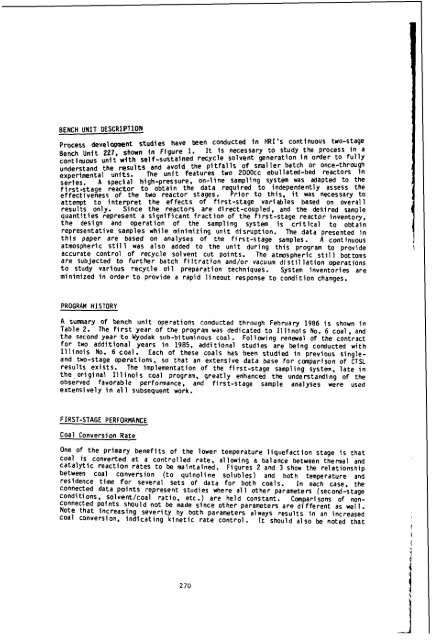Liquefaction co-processing of coal shale oil at - Argonne National ...
Liquefaction co-processing of coal shale oil at - Argonne National ...
Liquefaction co-processing of coal shale oil at - Argonne National ...
You also want an ePaper? Increase the reach of your titles
YUMPU automatically turns print PDFs into web optimized ePapers that Google loves.
BENCH UNIT DESCRIPTION<br />
Process deve1opmnt studies have been <strong>co</strong>nducted in HRI ‘S <strong>co</strong>ntinuous two-stage<br />
Bench Unit 227, shown in Figure 1. It is necessary to study the process in a<br />
<strong>co</strong>ntinuous unit “4th self-sustained recycle solvent gener<strong>at</strong>ion in order to fully<br />
understand the<br />
and avoid the pitfalls <strong>of</strong> smaller b<strong>at</strong>ch or once-through<br />
unfts. The unit fe<strong>at</strong>ures two 200Occ ebull<strong>at</strong>ed-bed reactors in<br />
series. A special high-pressure. on-line sampling System was adapted to the<br />
first-stage reactor to obtain the d<strong>at</strong>a re uired to independently assess the<br />
effectiveness <strong>of</strong> the two reactor stages. hior to this, it was necessary to<br />
<strong>at</strong>tempt to interpret the effects <strong>of</strong> first-stage variables based on overall<br />
results only. Since the reactors are direct-<strong>co</strong>upled, and the desired sample<br />
quantities represent a significant fraction <strong>of</strong> the first-stage reactor inventory,<br />
the design and oper<strong>at</strong>ion <strong>of</strong> the sampling system is critical to obtain<br />
represent<strong>at</strong>ive samples while minimizing unit disruption. The d<strong>at</strong>a presented in<br />
this paper are based on analyses <strong>of</strong> the first-stage samples. A <strong>co</strong>ntinuous<br />
<strong>at</strong>mospheric still was also added to the unit during this program to provide<br />
accur<strong>at</strong>e <strong>co</strong>ntrol <strong>of</strong> recycle solvent cut points. The <strong>at</strong>mspheric still bottoms<br />
are subjected to further b<strong>at</strong>ch filtr<strong>at</strong>ion and/or vacuum distil l<strong>at</strong>ion oper<strong>at</strong>ions<br />
to study various recycle <strong>oil</strong> prepar<strong>at</strong>ion techniques. System inventories are<br />
minimized in order to provide a rapid lineout response to <strong>co</strong>ndition changes.<br />
PROGRAM HISTORY<br />
A sumnary <strong>of</strong> bench unit oper<strong>at</strong>ions <strong>co</strong>nducted through February 1986 is shown in<br />
Table 2. The first year <strong>of</strong> the program was dedic<strong>at</strong>ed to Illinois No. 6 <strong>co</strong>al, and<br />
the se<strong>co</strong>nd year to Wyodak sub-bituminous <strong>co</strong>al. Following renewal <strong>of</strong> the <strong>co</strong>ntract<br />
for two additional years in 1985, additional studies are being <strong>co</strong>nducted with<br />
Illinois No. 6 <strong>co</strong>al. Each <strong>of</strong> these <strong>co</strong>als has been studied in previous single-<br />
and two-stage oper<strong>at</strong>ions, so th<strong>at</strong> an extensive d<strong>at</strong>a base for canparison <strong>of</strong> CTSL<br />
results exists. The implement<strong>at</strong>ion <strong>of</strong> the first-stage sampling system, l<strong>at</strong>e in<br />
the, original Illinois <strong>co</strong>al program. gre<strong>at</strong>ly enhanced the understanding <strong>of</strong> the<br />
observed favorable performance, and first-stage sample analyses were used<br />
extensively in a1 1 subsequent work.<br />
FIRST-STAGE PERFORMANCE<br />
Coal Conversion R<strong>at</strong>e<br />
One <strong>of</strong> the primary benefits <strong>of</strong> the lower temper<strong>at</strong>ure liquefaction stage is th<strong>at</strong><br />
<strong>co</strong>al is <strong>co</strong>nverted <strong>at</strong> a <strong>co</strong>ntrolled r<strong>at</strong>e, allowing a balance between thennal and<br />
c<strong>at</strong>alytic reaction r<strong>at</strong>es to be maintained. Figures 2 and 3 show the rel<strong>at</strong>ionship<br />
between <strong>co</strong>al <strong>co</strong>nversion (to quinoline solubles) and both temper<strong>at</strong>ure and<br />
residence time for several sets <strong>of</strong> d<strong>at</strong>a for both <strong>co</strong>als. In each case. the<br />
<strong>co</strong>nnected d<strong>at</strong>a points represent studies where a1 1 other parameters (se<strong>co</strong>nd-stage<br />
<strong>co</strong>nditions, solvent/<strong>co</strong>al r<strong>at</strong>io, etc.) are held <strong>co</strong>nstant. Comparisons <strong>of</strong> non-<br />
<strong>co</strong>nnected p<strong>of</strong>nts should not be made since other parameters are different as well.<br />
Note th<strong>at</strong> increasing severity by both parameters always results in an increased<br />
<strong>co</strong>al <strong>co</strong>nversion, indic<strong>at</strong>ing kinetic r<strong>at</strong>e <strong>co</strong>ntrol. It should also be noted th<strong>at</strong><br />
2 70

















